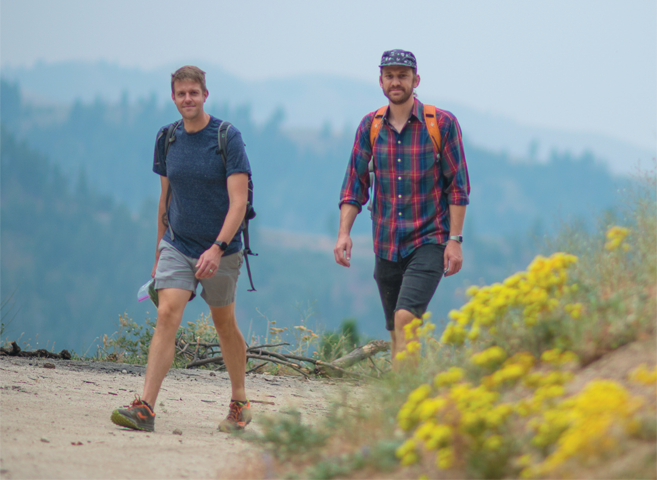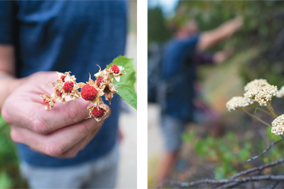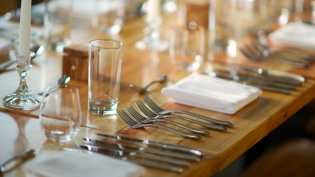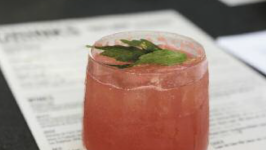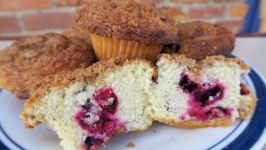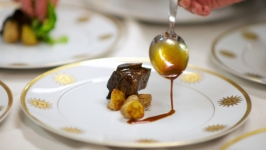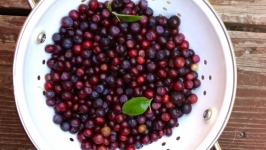Foraged Libations
The series of foraged beers Woodland Empire has been quietly cranking out in a partnership with The Modern Hotel and Bar got its start, somewhat ironically, through cocktails in Texas, then Idaho.
Rob Landerman, who owns Woodland with his wife, Keely, had been working at Ranger Creek Brewery in San Antonio, Texas, where he oversaw the production side of the brewery. Twice a week he would drive to Houston to drop off beer, a trip that often included a stop at a local cocktail bar and one particular mezcal-based drink. Rob got it in his head that he and Keely could re-create those flavors using their brewery skills.
“It was our first time diving deeper into a beer’s ingredients,” he said. “We were trying to make the flavors of the cocktail with beer ingredients.”
That new perspective on brewing stuck with the Landermans as they looked around the country, plotting where they would open their own brewery. Ingredients were one of their top priorities, particularly native plants that they could forage. Boise jumped out at the couple as a perfect candidate.
“We were trying to find interesting ingredients that were still accessible,” Keely said.
When they moved to the Treasure Valley in 2013, the Landermans were surprised to find that foraged ingredients weren’t a bigger part of the restaurants and bars.
“I thought we’d be late to the game, but there wasn’t really anyone working with those kinds of ingredients,” Rob said.
As they planned their nascent brewery, often around tables at the famously cocktail-focused Modern, the Landermans started to fall in with the staff. They began chatting with former bar manager Michael Bowers, who already had been amassing information about edible plants in the valley. As they got to know one another, they found out they had a lot in common, including a strong drive to find new flavors and ingredients.
“It turned out Michael and I are big nerds,” Rob said.
Michael Bowers started foraging in 2014, incorporating newly found items into drinks at The Modern, introducing them to cooks and bringing them home for his own enjoyment. On a recent weekday he was setting out to collect watercress and sunflowers for a dinner party. The sunflowers were bound for a corn and almond soup with confit potatoes, pickled chard stems and leek ash. The watercress was a wild addition to a simple salad.
At The Modern, Michael worked some foraged items into a drink called Due Diligence, which features a hyssop syrup. Another, called The Bonneville, features cottonwood buds.
“I just see it as another ingredient,” he said.
Michael’s current kit includes tweezers, an X-acto knife, hand lenses, two out-of-print reference books and Flora of Idaho, which contains as much Latin as it does English.
As his foraging knowledge started to grow, he thought about different uses for these new ingredients. A simple text from Bowers to the Landermans kicked off the beer series.
“Thinking about rotational series on foothills ingredients,” read a text from January 2016.
The Landermans were game for the idea and the group set out soon after. For their first outing, they picked rose hips. They hiked through the snow on a trail near Crane Creek and were able to collect 10 to 15 gallons of the fruit. They brewed a rose hip saison soon after.
Since then the collaborative series has included a pale ale brewed with burnet, a schwarzbier with hyssop, a pilsner with cottonwood buds and a dry stout with smoked currants, among others. This fall, Woodland plans to release a beer made with balsam root, which also is known as arrowroot.
The line of beers have bled into other collaborations. A dinner held earlier this summer at State & Lemp featured a full menu of foraged beers. The brewery poured a gruit made from pine tips, yampah, sumac and nasturtium; a gratzer made from sagebrush-smoked wheat and pineapple weed; a pilsner brewed with burnet and a saison that used dandelions and a green strawberry sour.
“The goal is never to do something that is weird for the sake of being weird,” Rob said.
Another offshoot from the foraged series is a planned partnership between Woodland and Beers Made by Walking, a nonprofit organization that has chapters in California, Colorado, Oregon and Washington. The group links breweries and environmental nonprofits to create foraged beers. A part of the sales from the resulting beer is donated to the partnering environmental group. Woodland is hoping to team up with the group in the fall.
The official beer series from Woodland and The Modern has followed a hard-and-fast release schedule of “a few to several a year,” Bowers said. Most of the bottles have been sold at The Modern. The sporadic releases are a product of busy schedules, but also the unpredictability and limited window to use some foraged ingredients.
“There have been times when Michael shows up with an ingredient and says, ‘You probably have a week or two to do something with this,’” Rob said. “Or, ‘You have to use this right now.’”
While there are other breweries foraging, it’s still uncommon.
Scratch, in Ava, Illinois, has garnered attention for their penchant for foraged ingredients. The small brewery operates a farm a few miles from the Shawnee National Forest in southern Illinois. They regularly feature foraged items such as elderberries, nettles, hickory, maple sap, juniper and chanterelle mushrooms.
Fonta Flora in Morganton, North Carolina, is another brewery often praised for using foraged items. The brewery, which opened in 2014, focuses on foraging and partnerships with local farms to bring “brewing back to its agricultural roots.” A recent tap list showed a saison aged with dandelion flowers and a wild ale brewed with local grapes, among others.
Even a brewery in Bristol, England, was advertising a coastal foraging outing last fall.
For the Landermans and Bowers, foraging brings a lot of intangible benefits and responsibility. The trio—which often includes the Landermans’
children, Faolan, 9, and Henry, 6—regularly plucks invasive species while looking for usable ingredients. They follow strict rules to avoid decimating plant populations or damaging the landscape: They don’t return to the same plants year after year, harvest less than 10% of a plant population and don’t dig up or kill plants, only taking pieces that won’t affect the plant’s health.
While working with foraged ingredients is exciting, it is unpredictable. Many of the guidebooks for edible plants aren’t specific to the area or contain dense, difficult-to-understand information.
“Unless you’re able to do a lot of experimenting and testing, you’re sometimes going in blind,” Keely said.
“This year we made a death cocktail,” Rob said, tongue-in-cheek, referring to the infamous beer his crew made using raw morel mushrooms. After everyone got unpleasantly, if mildly, ill, he found out that although cooked or dried morels work fine, raw morels and alcohol
don’t mix.
Another time, Keely’s sinuses “blew up” when she tried a handful of cottonwood buds she was picking for a beer while Michael accidentally found out that cooking erodium—a small, weed-like plant—can lead to a smell like “fish that’s been left out for a few days.”
Despite the occasional misstep, foraging is an important exercise for Bowers and the Landermans. Bowers hopes to keep providing new ingredients to e Modern, while the Landermans already are planning new beers and collaborations. Rob said his ultimate goal is to
make foraging less of a buzzword. He wants it to be more common.
“I think that’s the goal,” he said. “To normalize it.”


